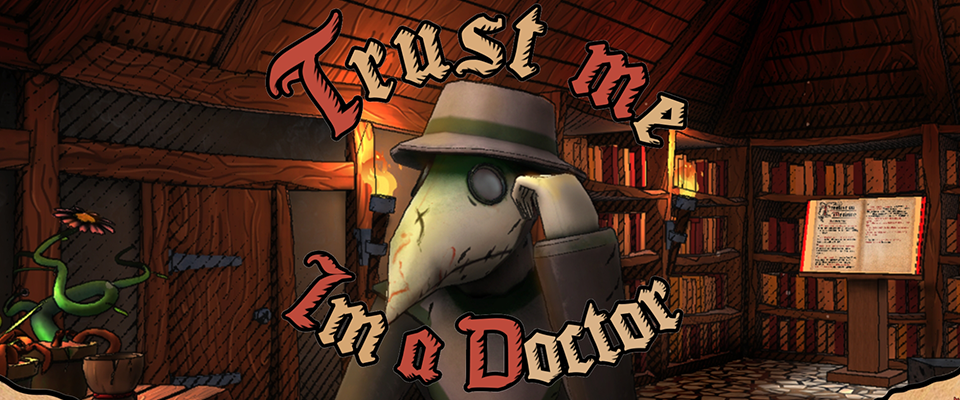Week 2: Iterations on mechanics, art bible and engine
Welcome back to our barber shop💈🔪, dear customer. What bring you to our establishment? An extreme case of bubos? Did you run out of your daily leeches? Or just out of curiosity, well we are quite busy, but maybe we can solve the last one.
This is what we have been amputating 🩸doing this week:
Art
Art bible
We have focused into analyzing and settle more the art style we want to go for. First we have define the color palette and the UI, same as the shape language. This has taken up some time as we have discussed and iterated on ideas once and again till we found what we were looking for:

Shaders
We did an extra step into shaders. But before that we had to analyze the medieval illustration style and to find the best translation in to a shader. This has being our advances on the topic after the whole process:
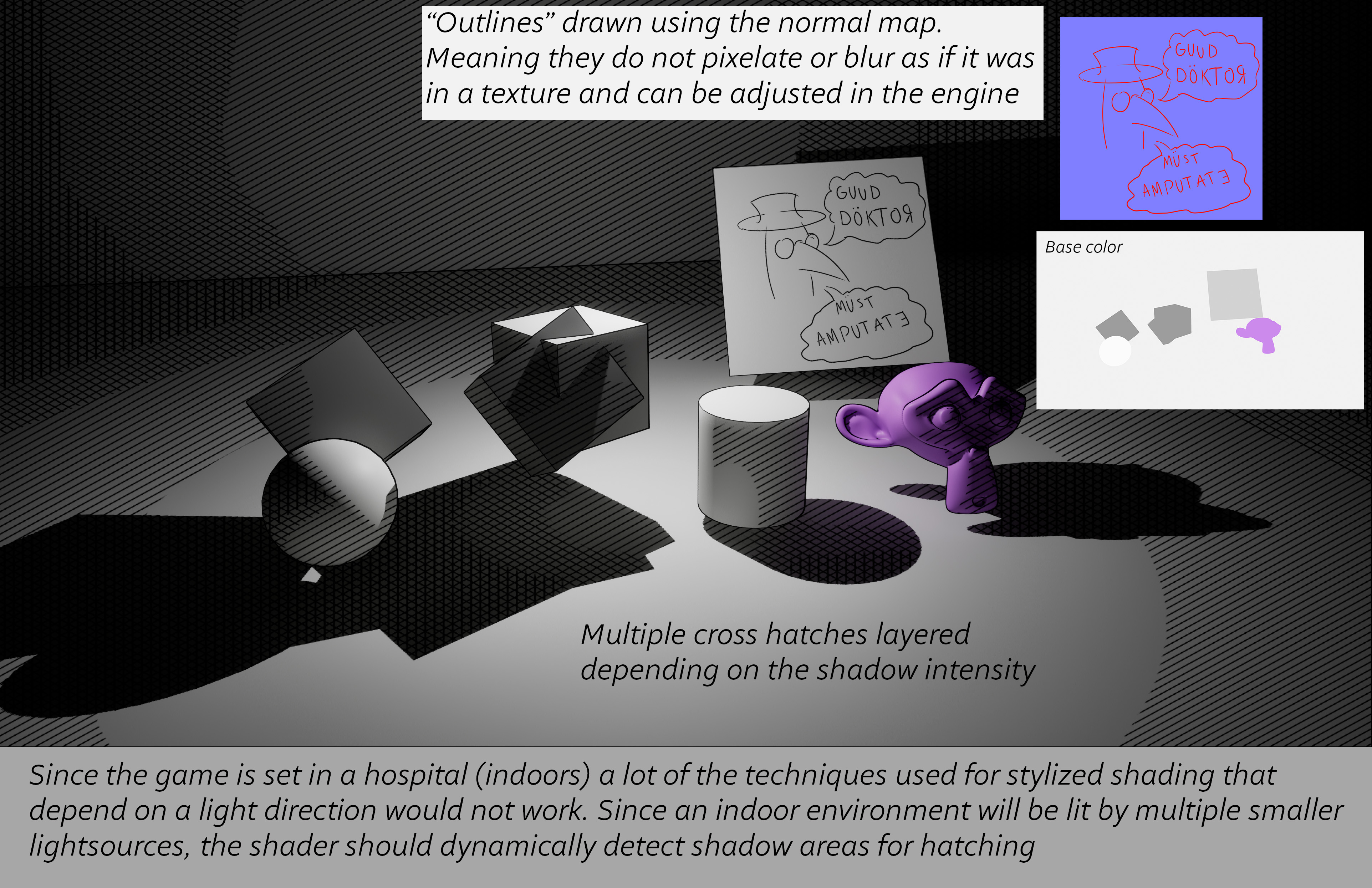
Programming
Two monitors prototypes
Our programmer found a dead end after another trying to find a way to make the two monitors work in Unreal Engine:
1. First she tried using this plugging: https://github.com/Batname/UE4MultiWindow
She managed to recompile for UE5 but the website with the tutorial was dead so it wasn´t possible to figure it out without further instructions.
2. After she tried this second plugging : https://www.unrealengine.com/marketplace/en-US/product/second-in-game-viewport-window/questions
In this one, she was also able to compiled it but did not really work, as the second monitor was only for editor and debug.
3. Without more options in Unreal the programmer moved to Unity 2022.3, where she was able to develop the feature:
Unreal Engine 5 or Unity2022.3?
In a twist of our fates Unity 2022.3 seems to be our only option to develop the game because:
- The possibility to make a display with two screens seems to only be reachable in Unity.
- Both of our coordinators have expertise in Unity and specially as a technical artist.
- In a C# environment we can count with an extra backup on programming, as the IGP (Pablo) is versatile in it.
Design
We take great inspiration in Keep Talking and Nobody Explodes (KTANE), but we want to diverge from their gameplay to make an unique game. For that, our designer has research how the game was made in design, art and programming level. And he has iterated and developed the mechanics proposed for our game. Another idea he have settled is that our game is a multiplayer game based on communication, focusing our mechanics in creating interesting and funny communication opportunities.
Iterations on reading mechanic to make it unique
Principles
- It covers all the possible scenarios
- Extremely clear
- No ambiguous rules
- It is dense enough so is not easy to memorize
- Each sections difficult communication in a way
- One has a lot of text clutter
- Another ones presents a drawing that you have to interpretate
- Short memory tests (previous steps conditionate the answer)
Starting from a base design close to KTANE, we have look for a way to twist it. The main idea would be to use medieval illustration to force the player that reads the book to also describe some procedures to the healing one, creating more communication opportunities.
We pondered between the idea of making the book a combination of illustrations and descriptive text or make it only an illustrated book. And we find more interesting the first idea.
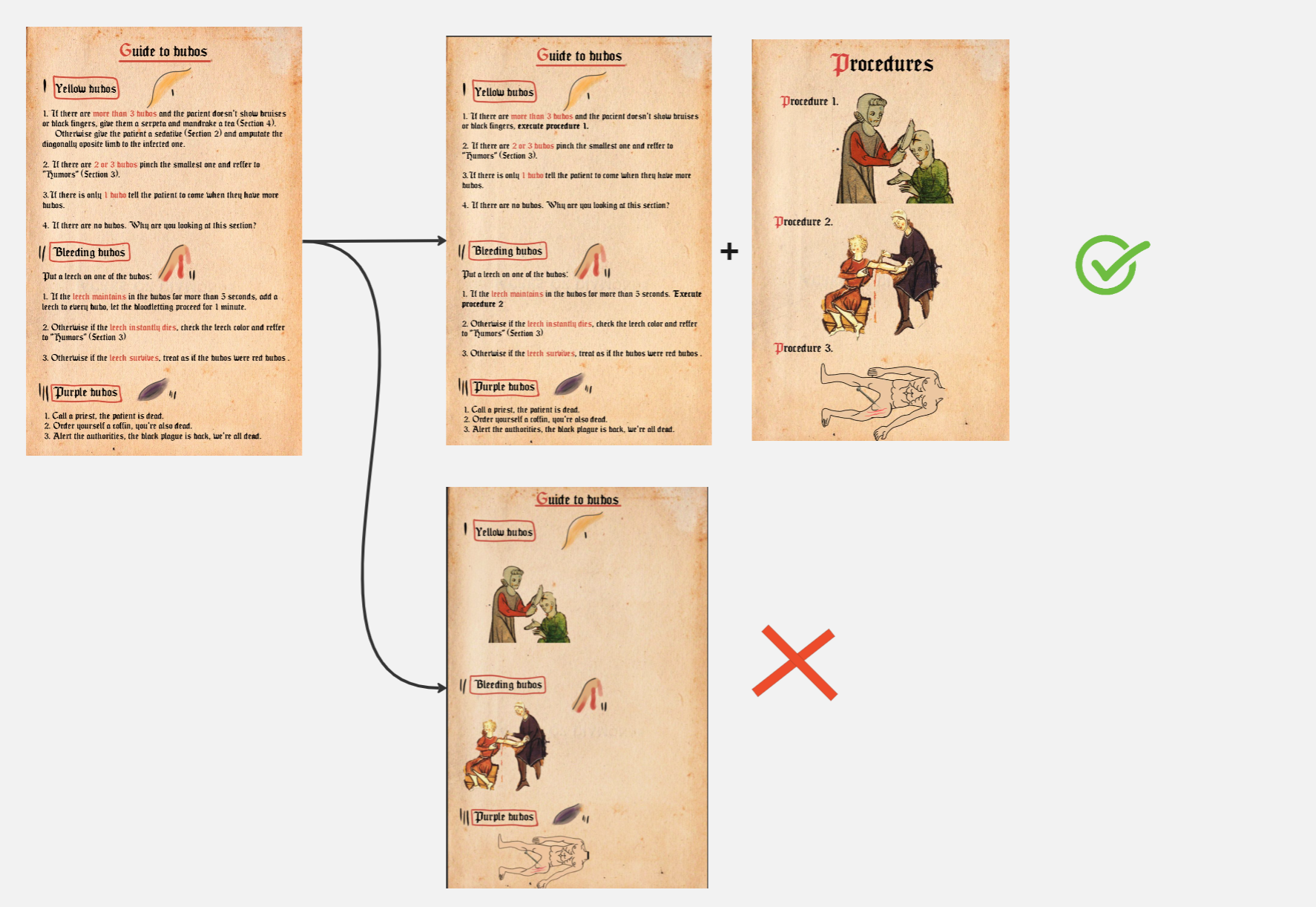
Iterations and develop on healing mechanic
The mechanic is divided into healing process and how the deseases works:
Healing:
. Option 1: KTANE model
Hard decisions and easy input. Based on knowledge, not skill. Same as KTANE, as the game was able to attract people that didn't consider themselves as gamers, the developers didn't want them to feel that they had to train cutting wires to be able to beat the game.
. Option 2: Hardgamer model
Based on knowledge and skills.
- It will bring another dimension to the game, making it even more different
- It will make it go away from the fundamental of a game about communication. In the sense that you can fail the game for something else (your skills) than a bad communication.
- It may require more programming
Deseases:
.Option 1: Modular body parts
The body is made out of body parts (Hands, feet, arms, legs, chest, stomach and neck). They dont look like different parts but the player can choose to focus in each one of them, getting the camera closer and allowing to interact with the deseases.
- Pros:
- Good adaptation of the gameplay, allowing an overview and a closer look of deseases and gameplay itself
- Cons
- Closer to the already created KTANE
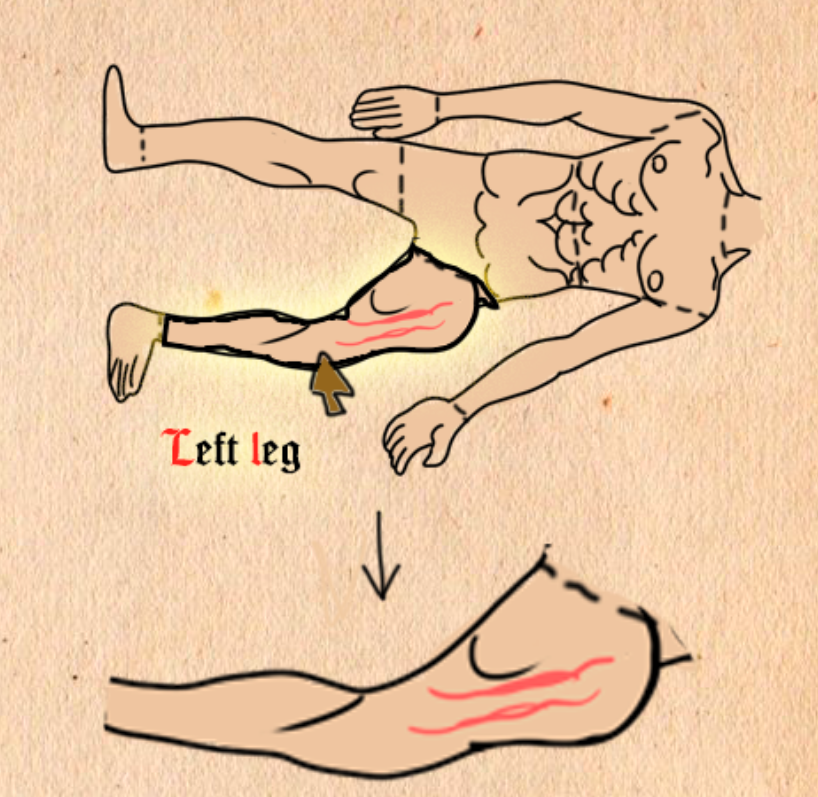
.Option 2: Deseases appear around the body
The body is an unit, the player can zoom in around it looking for information. Deseases can be interacted with by taking the surgery equipment (scalpel, syringe and handsaw).
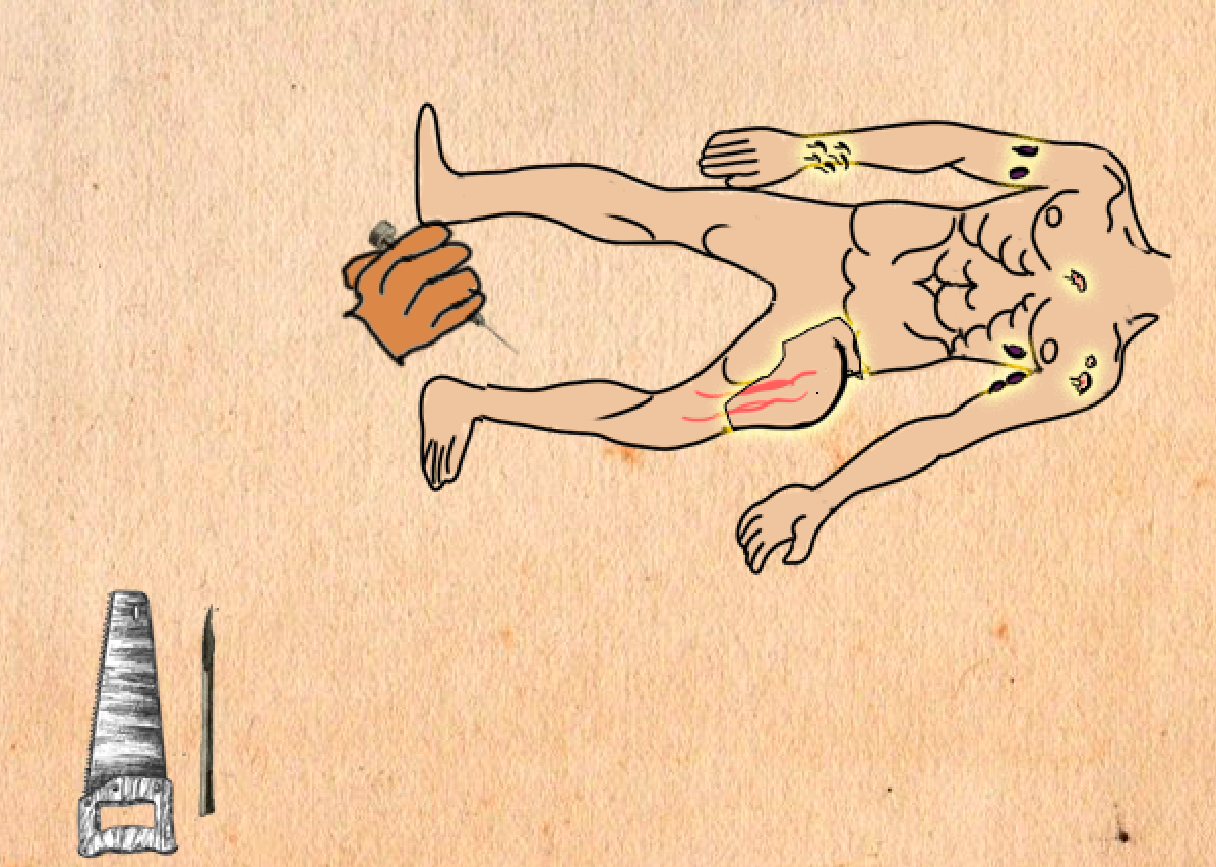
Iterations and development on mixing mechanic
Mixing mechanic is an extension of the healing mechanic, adding an extra variable to the gameplay. It works with the same core mechanic of communication.
In the table you'll have to convine plants and materials to create healing ointments.
This are the two proposals for the mechanic:
- The mixing is executed in an extra table, giving access to it to both of the players.
- 1.1 The instructions are still in the book, prioritizing for the healing player to be the one that access to it.
- 1.2 The instructions are in the mixing table itself, an infographic of the combinations and results.
- The mixing tools are on the healing table, only accesible if you are also healing the patient.
- 2.1 The instructions are still in the book
- 2.2 The instructions are in the healing table itself, an infographic of the combinations and results.
- The mixing table is on the book table, and only the one reading the book and instructions is able to access to it.
- 3.1 The instructions are still in the book, making the book player do two things at the same time
After thinking about all the possible combinations the designer finds more interesting the options 1.2 and 2.1. Both options of having an extra table or having the mixing tools in the healing table will create more communication opportunities. To decide which one will work best for the game we would need some feedback and playtest. We will focus on that for next week.
Iterations enhancing communication
Looking for unique ways to enhance the communication opportunities:
- Solving conflicts and taking decisions
- Need to send information that the other one doesn't have
- Need to do something at the same time
The first two options have been already cover by the book, mixing and healing mechanic combination.
Nevertheless the third one open new chances of making the game unique. As is not a mechanic existing in TKANE.
We could implement this mechanic by extra actions like two people helping while healing or a healing process in which you have to fastly time the information you receive and the action you take.
Both are great ideas but they are also on a scope of a whole game, as adding extra mechanics is not feasible. And the development of the communication mechanic into a timing, will require a previous expertise by the players, so they would have had to play the game beforehand to not be overwhelmed by the amount of tasks and stimulus.
Conclusions
We have now a definitive engine (unless a miracle happens) and we have strong mechanics to prototype and get feedback about.
Our next step will be:
. Art: finishing the art bible completely and prototyping the style to see if it is feasible.
. Programming: prototype the mixing and healing mechanic.
. Design: get players feedback on the mechanics.
And that's all for now our most beloved clients, may sickness and plague bestow upon thee so we see each other again soon in our barber shop!🩻🩻
Files
Get Trust Me I'm A Doctor
Trust Me I'm A Doctor
Multiplayer game for two unexperienced doctors
| Status | Released |
| Authors | Pablo Mata, Lorenzo Campi, Revekka Andronikidu, RuutaK |
| Genre | Puzzle |
| Tags | Comedy, communication, Multiplayer, plague-doctor |
| Languages | English |
More posts
- Week 10: Wax on, wax offMay 22, 2024
- Week 9: Production finished!May 15, 2024
- Week 8: GameloopingMay 08, 2024
- Week 7: Second sprintMay 01, 2024
- Week 6: End of the first sprintApr 24, 2024
- Week 5: Second production weekApr 17, 2024
- Week 4: Start of productionMar 28, 2024
- Week 3: Preparing for productionMar 20, 2024
- Week 1: Research and prototypesMar 06, 2024
